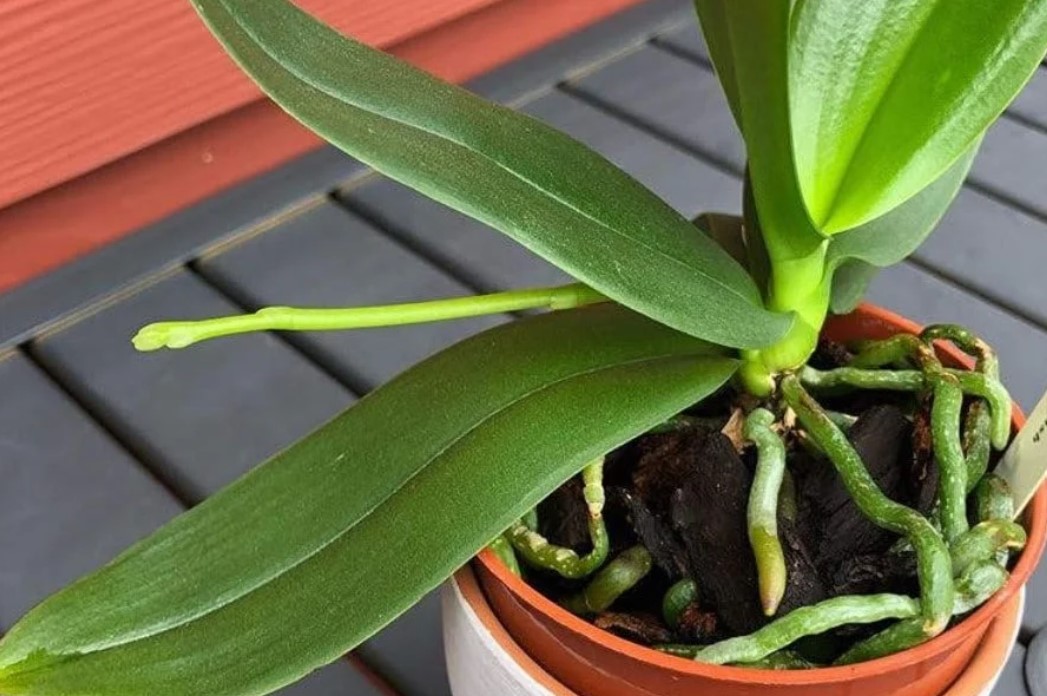How to grow orchids without soil, also known as “bare root” growing, is a method of orchid cultivation that mimics natural conditions and eliminates most common problems associated with pot-bound growing.
This method offers an aesthetically pleasing way to display your orchid plants, while ensuring they are receiving the nutrients and moisture they need to thrive.
The bare root method can be used to grow both terrestrial and epiphytic orchids – the latter being native to tropical regions that live in trees, rocks and other natural anchors rather than soil. In order for an orchid to transition successfully into a bare root environment, you must have an appropriate substrate.
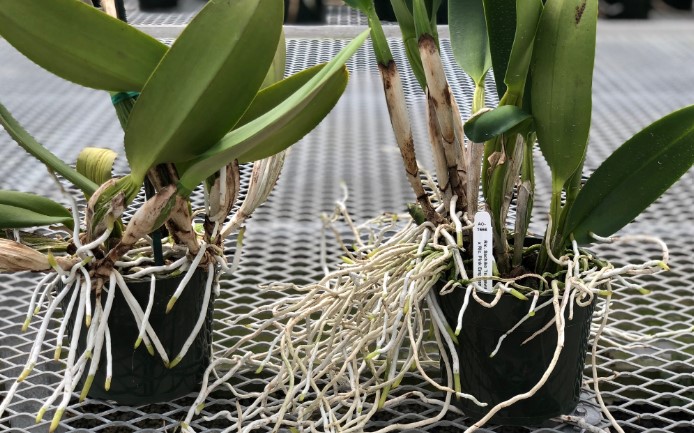
What Exactly Does Growing an Orchid Bare Root Mean?
Growing an orchid “bare root” is a great way to bring the look of a tropical rainforest into your own home or garden. Bare root orchids are grown without soil or potting media, and require special care and attention to thrive. When grown correctly, these wild-looking plants can add an exotic flair to any living space.
So, what exactly does growing an orchid bare root mean? In its native rainforest habitat, an orchid would be naturally exposed to air and sunlight without any additional soil or potting media. When grown in this way, the roots of the plant are able to reach out into the air, allowing it to access.

Hydroponic orchid growing is also called water culture and may prove to be the solution for an ailing orchid.
Does Bare Root Mean Completely Bare? Not Necessarily
Growing orchids “bare root” does not necessarily mean completely removing all of the soil from their roots. The idea is to provide a more ventilated environment for the orchid’s roots, which can be accomplished by using a small amount of potting media like sphagnum moss or orchid bark in a ventilated pot.
This allows the orchid’s roots to get enough oxygen while still providing support and water retention.
When growing an orchid “bare root,” the goal is to provide a more ventilated environment for the orchid’s roots without sacrificing too much in terms of moisture and humidity regulation – conditions.
What Are Some Examples of Growing an Orchid Bare Root?
Growing an orchid bare root is a great way to showcase the lushness of its aerial roots. There are countless creative ways to display and grow your orchids. For instance, you can mount a phalaenopsis on wood, cork, ceramic, or even attach it to a tree. Orchids in hanging baskets and custom wall panels are also becoming increasingly popular.
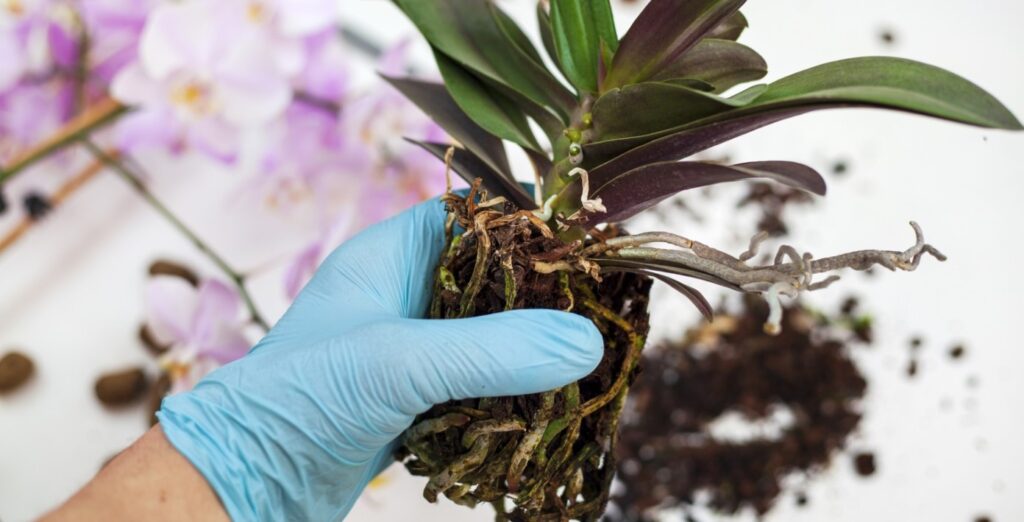
What’s more, you can even create stylish orchid displays with driftwood structures for a truly eye-catching piece of home decor. Whatever your style may be, there is sure to be a way to make growing an orchid bare root work for you.
What Types of Orchids Can Grow Without Medium or Pots (Bare Root)? Orchids That Don’t Need Growing Media
Epiphytic and lithophytic orchids have an amazing ability to grow without needing soil, which makes them ideal for growing bare root. Epiphytes live on the surface of trees, shrubs, rocks, and soils with their roots exposed to absorb moisture from the environment around them.
This is why they make great candidates for growing without any medium or pot. Popular epiphytic orchids include phalaenopsis, vanda, cattleyas, dendrobiums and oncidiums. Meanwhile, lithophytes such as paphiopedilums tend to prefer growing in places where they have access to rocks and crevices where.
Bottom-line: Grow Orchids Without Medium or Pots If You Have the Right Type of Orchid
Growing orchids without soil or pots is possible if you have the right type of orchid. Epiphytic and lithophytic orchids are both suitable for bare root growth as long as their moisture needs can be met.
With these two types of orchids, root systems are still active and absorb moisture from the air rather than from soil. So if you can maintain the humidity levels and water needs of the orchid within your climate, then it’s possible to grow them without soil or pots.

That said, terrestrial orchids are not suitable for this type of growing method as their root systems rely on soil in order to absorb moisture and obtain nutrients.
How Can You Replicate the Humid Conditions That an Orchid Requires in a Dry Climate?
In a dry climate, it can be difficult to replicate the humid conditions that orchids need for proper hydration. One way to provide more water to your orchid is with the “water culture” method.
This involves placing your orchid above a container of water and allowing its roots to soak for a certain amount of time each day, depending on the weather and your particular orchid. This is an effective way to provide more hydration in a dry climate, but it requires you to keep up with a regular schedule of watering.
B. Growing Your Orchid Bare Root in a Humid Climate: More Possibilities to Grow Bare Root
Under these balmy conditions, you could consider mounting your orchid on a piece of bark, cork, tree fern fiber, or other support in order to provide the air circulation and drainage that it needs. This is also a great way to show off the beauty of your orchid since it will display it in full view.

Read also: Healthy orchid roots
If you have access to a greenhouse or conservatory, you can also grow your bare root orchid in containers filled with a special orchid medium. This particular method provides the right amount of moisture and air movement needed for optimal growth and health of your bare root orchid.
How Can You Replicate the Humidity & Hydration Requirements That an Orchid Receives in the Wild?
Growing bare root orchids in a warm, tropical climate gives the ideal conditions for the plants to thrive. The heat and humidity of such areas provide just the right environment for orchid roots to remain hydrated and healthy.
The benefit of living in such a climate is that orchids can be easily watered and misted with a hose or a spray bottle. Taking advantage of the ventilation and hydration opportunities available, you can also easily provide your orchid with water by placing it in a bucket as needed.
To replicate the humidity and hydration requirements of an orchid that would receive in its natural environment, you should ensure that there is sufficient moisture in the air.
Can Your Grow an Orchid Bare Root Indoors?
Indoor Growing Challenges Require More Dedication
Growing an orchid bare root indoors requires a significant amount of effort and dedication. As orchids are tropical plants, they require high humidity levels and plenty of light to survive. Indoor air is often dry and heated, reducing the opportunity for the plant to thrive.
In order to grow an orchid indoors, you will need to provide the right environment, including high humidity levels, frequent misting and daily watering. You will also need to take into account the light requirements of your particular orchid species in order to give it the best chance to survive.
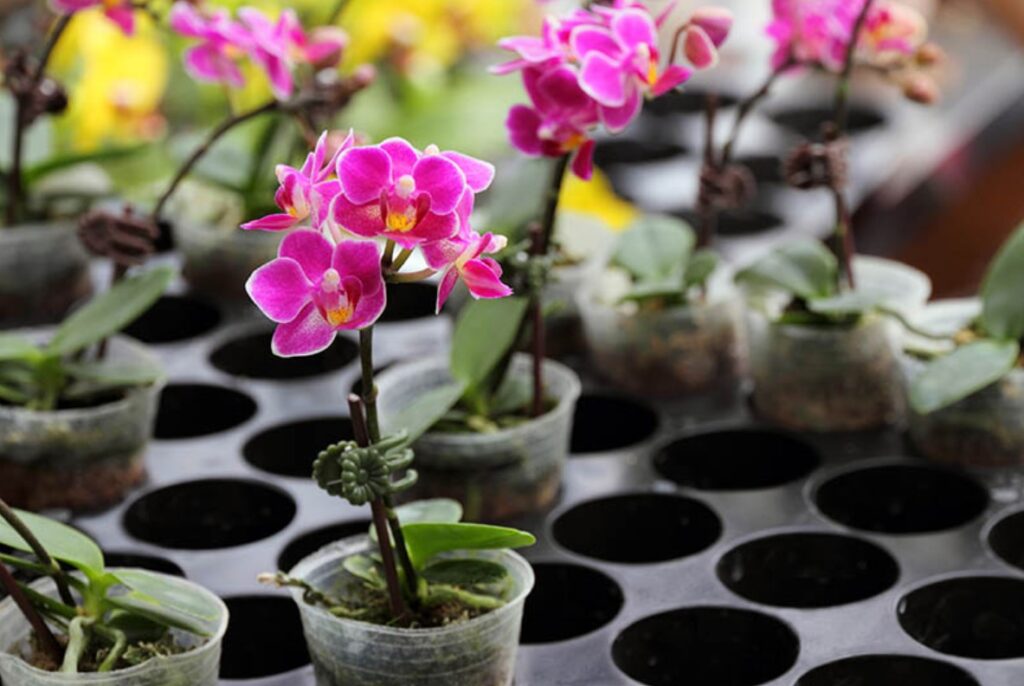
It is possible to successfully grow an orchid indoors – it just requires more dedication, attention and care than if you.
Two Ways to Grow Orchids Without Medium or Pots Indoors & How to Meet Their Moisture Needs
Mounting An Orchid & A Modified Bare Root Arrangement
Mounting an orchid is a great way to bring the beauty of nature into your home. It requires more upkeep than potting an orchid, but it can be done with some basic knowledge and care. When mounting an orchid, choose smaller to medium-sized plants that are better suited for high humidity environments.
Mounting should be done carefully, as the roots need to be exposed and kept stable. To help keep the orchid’s roots hydrated, you can wrap sphagnum moss around them to increase moisture retention and reduce moisture loss. This modified bare root approach may be useful in drier indoor environments.
Water Culture in Vases
Water culture is an effective way to efficiently hydrate your orchid when living in a dry environment. This method can be used with smaller orchids and requires placing the plant over a small vase, allowing its roots to soak water for a period of time. Depending on the season and specific type of orchid, this process should take up to 15 minutes a few times a week.
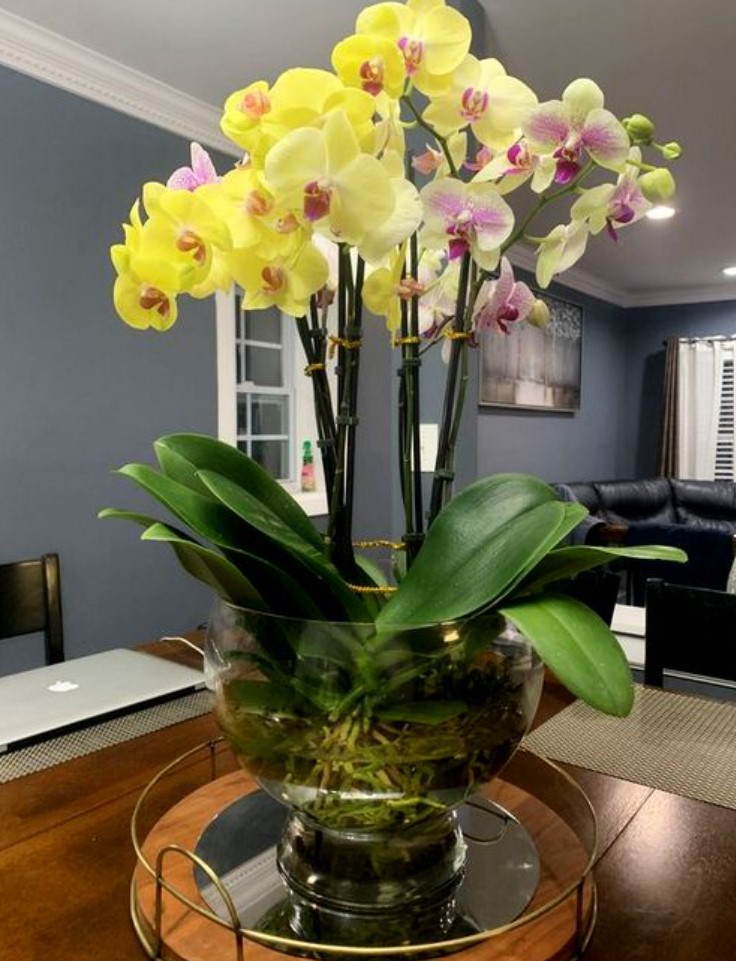
Water culture in vases is an excellent way to make sure your orchid gets the hydration it needs without overwatering. When using this method, make sure to check the root system of your orchid for any signs of fungus or rot before continuing with the process.
Bottom-line: Grow Orchids Without Medium or Pots by Considering the Climate or Conditions Where You Will Grow Your Orchid
Some advantages and disadvantages of growing orchids without soil
Advantages:
- Epiphytic and lithophytic orchids are natural habitat.
- We rule out the growth of pathogens in the soil that cause root decay. This is important because root rot is common for orchids.
- Do not transplant the plant. Transplantation is a great stress for the plant.
- We dilute nutrients with water to ensure optimal nutrient intake and to avoid overdose;
- The plant remains strong and healthy because it gets all the necessary amount of valuable trace elements, and the roots are protected from drying out;
- Automatic watering systems can be made, which facilitates the care of growing orchids.
.

Disadvantages:
- The need often prepares nutrient solutions;
- Orchid owners do not always know how often to water and water very often. In this case, the leaves turn yellow and fall;
- Many direct sunlight can hit the roots and the root mass can be burned;
- Cold and draughts are also very bad effects on the plant and it may die.
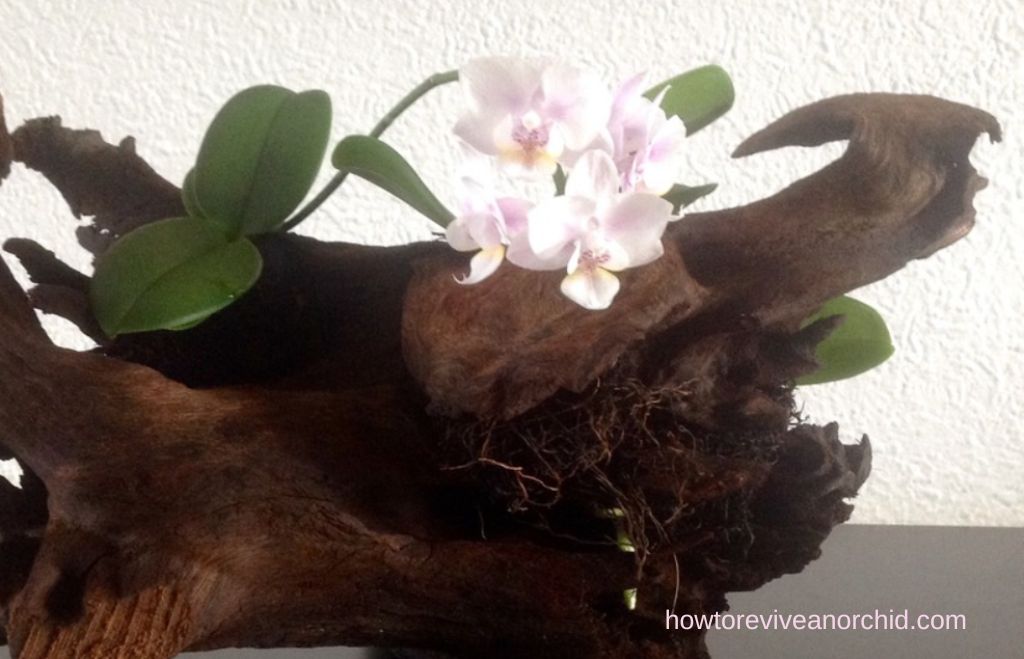
Conclusion
Growing orchids without soil and environment is an easy way to start growing orchids. This method can be much easier than growing in the ground. You need to follow some rules of growing orchids and your plants will please you with their kind.
Answers on questions:
Can orchids grow in just water?
Orchids are beautiful and delicate flowers that can bring a lot of beauty to any home. Many people don’t realize that you can actually grow orchids in water, rather than soil.
This is an extremely convenient and low-maintenance way to keep your orchids healthy and happy, as long as you provide them with the proper care. Can orchids grow in just water? The answer is yes, it is possible to keep your plant alive and thriving with just a little bit of effort.
When growing orchids in water, it’s important that you provide them with plenty of light and warmth. A south facing window can provide enough sunlight for them to survive, or you can use artificial lighting if necessary.
Additionally, make sure to keep the water temperature between 70-80 degrees F at all times. You should also make sure that the container is big enough for your plant to grow and get enough oxygen, as well as changing the water every two weeks.
Do orchids like to sit in water?
No, orchids don’t like to sit in water. Orchids are epiphytic plants, meaning they typically grow attached to other trees and obtain their moisture from the air. If they are exposed to too much water, their roots can rot and the plant can die.
This is why potting them in a bark-based potting medium is often recommended, as the bark helps to provide well-draining soil and prevents the plant from sitting in water.
Once planted in a bark-based potting medium, there are two main ways of watering orchids: watering from below and watering from above.
Do orchids need soil or bark?
Orchids are beautiful, vibrant plants that require proper care in order to thrive. When it comes to their growth medium, orchids need a particular type of material in which to grow.
While some may assume that soil is the best option for these plants, this is not necessarily true. In fact, most orchids do better when they are grown in bark or other materials that provide both aeration and drainage.
When choosing a growth medium for your orchids, it is important to consider the type of material you will be using. Do orchids need soil or bark? The answer is no – most orchid species prefer a mixture of bark and other materials.
Can you grow an orchid from a leaf?
Can you grow an orchid from a single leaf? Unfortunately, the answer is no. This method of re-growing a plant only works for certain species, such as succulents and Begonia.
Чтобы это работало, к листу должен быть прикреплен стебель, потому что эта часть растения содержит нужные клетки, необходимые для процесса отрастания. Вырастить орхидею из одного листа невозможно, и вместо этого следует использовать другие методы, такие как проращивание семян или черенкование стебля. Читайте также…
Читайте также:
Can orchids grow in just water?
Some orchids can grow in just water, but most orchids prefer to grow in a well-draining potting mix that allows for adequate airflow and prevents the roots from becoming waterlogged. While some orchids can survive in water, they may not thrive and can be more susceptible to root rot and other issues. It’s generally best to provide orchids with a suitable potting mix and to water them appropriately based on their individual needs.
What is alternative soil for orchids?
The most common alternative soil for orchids is a specialized orchid potting mix, which typically contains materials such as bark, sphagnum moss, perlite, and charcoal. These materials provide good drainage and aeration for the orchid’s roots, while also allowing for moisture retention. Other alternative growing media for orchids include coconut coir, lava rock, and tree fern fiber, but it’s important to choose a medium that is suitable for your specific type of orchid and growing conditions.
Do orchids like to sit in water?
No, orchids do not like to sit in water. Overwatering and waterlogged conditions can cause root rot and other issues for orchids, as they require well-draining potting mix and adequate airflow to thrive. It’s important to water orchids appropriately based on their individual needs and to allow excess water to drain out of the bottom of the pot to prevent water from pooling around the roots.
How often should I water my orchid without soil?
If your orchid is growing without soil, such as in moss or bark, you should water it when the growing medium feels dry to the touch. The frequency of watering will depend on the humidity levels, temperature, and other factors in your growing environment, as well as the specific needs of your orchid species. As a general guideline, you can water your orchid once a week, but it’s important to check the growing medium regularly and adjust your watering schedule as needed.
Can orchids grow without sunlight?
Orchids require light to grow and bloom, and they generally need bright, indirect sunlight to thrive. While some orchid species can tolerate lower light levels, they still require some degree of light to maintain their health and produce flowers. Without adequate light, orchids may become weak and leggy, fail to bloom, or even die. If you’re growing orchids indoors, you can place them near a bright window that receives indirect sunlight, or you can use artificial grow lights to provide the necessary light spectrum for orchid growth.
How do you water an orchid without flowers?
Water an orchid without flowers by removing it from its container, saturating the potting mix with water, allowing excess water to drain, and returning the orchid to its container. Water only when the potting mix is dry to the touch.

